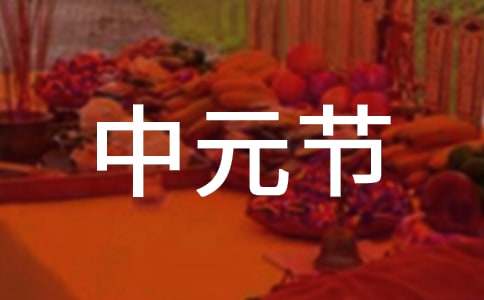- 相关推荐
中元节的由来英文版
中元节,俗称鬼节、施孤、七月半,佛教称为盂兰盆节。与除夕、清明节、重阳节三节是中国传统的祭祖大节,也是流行于汉字文化圈诸国的传统文化节日。下面就是小编整理的中元节的由来英文版,一起来看一下吧。

中元节的由来英文版:
The name "Yuan Zhong" originated in the Northern Wei Dynasty and was a Taoist statement. According to ancient records: one to the first fifteen is the "spring", as the day official blessing on July; fifteen is the "middle", as officials on fifteen October is "forgiveness; Yuan", as the official water solution on. According to the "practice" records: "in July motohi officer down, set the world of good and evil, then the night of Taoist chanting, also free day hungry prisoner." Therefore, in July 15th this day, all have rich folk religious worship to officials and ancestors.
The ghost festival is a product of Taoism and traditional folk China combination, the two to the corresponding, is mainly based on the same universe view: Heaven and earth, water three, deified for three days, the government department officer officer, officer under the water. Folk known as "three public", is the three official refers to the three gods.
Chinese Eastern Han Dynasty, Taoism has integrated Taoist View of the universe before the stage, need to first pass on the "three official calligraphy", were cast in the heavens and the earth, the water, said the three officer to repent of sins, to pray for peace. Through the development of the Six Dynasties period, three day and three yuan in the Tang Dynasty advocated the thought of combination, the official, Shangyuan, yuan to three yuan, down motohi stereotypes, worship worship, Najib blessing become three Yuan emperor Festival, Festival ceremony participation rate of officials. Tang and Song Dynasty, became the three motohi folk festival.
The ghost festival, Taoist temples, such as the Dianmen fire temple, the West will be outside the White Cloud Temple to pray for "good and peaceful" year "auspicious blessing Temple held as usual". Because of the psychological fear of Li, the people in the daily life of composite of Confucianism, Buddhism and Taoism, the the 15th day of the seventh month of the Chinese lunar calendar ghost festival called Halloween, known as the lunar July "ghost month".
The introduction of Buddhism, Buddhism is also a kind of their forefathers the religious rituals, known as "Wu Lanma Na" (India ULLAMBANA), namely "Obon will". Obon is the meaning of life is like the pain hung upside down, upside down in the tree on the head of the bat, hanging, miserable. In order to make people from a difficult situation, we need food for the vast cloth chanting, wandering souls. This is the month China ghost worship and Buddhism in the 15th day of the seventh month of the Chinese lunar calendar also agree without prior without previous consultation, the day held salvation method, which will also Ghost Festival and Meng LAN handed down.
翻译:
“中元”之名起于北魏,是道教的说法。根据古书记载:道经以正月十五是“上元”,为天官赐福日;七月十五是“中元”,为地官赦罪日;十月十五是“下元”,为水官解厄日。据《修行记》记载:“七月中元日,地官降下,定人间善恶,道士于是夜诵经,饿节囚徒亦得解脱。”因此,在七月十五日这一天,民间都会准备丰富的牲礼,祭拜地官大帝及祖先。
中元节是道教与中国传统民俗相结合的产物,二者能够相应,主要是基于同一宇宙观:即天、地、水三界,被神格化为天官、地官、水官所统辖的三界府署。民间通称的“三界公”,便是以三官泛指三界众神。
中国东汉末年,天师道便已综合前道教期的宇宙观,首过需上“三官手书”,分别投于天、地、水中,表示向三官忏悔罪过,以祈求平安。经历六朝时期的发展后,三会日与三元思想结合,在唐代官方的提倡下,上元、中元、下元等三元日定型化,成为祈福纳吉、祭祖拜神的三元节日,皇帝率百官参与节日仪式。唐、宋以后,三元日成为民俗节日。
中元节时,道教宫观,如地安门火神庙、西便门外白云观等为了祈祷“风调雨顺、国泰民安”每年照例举办“祈福吉祥道场”。因为惧厉的心理,民众于日常生活中复合儒、佛、道三教,将农历七月十五的中元节称为鬼节,称农历7月为“鬼月”。
佛教传入后,佛教中也有一种追荐祖先的超度仪式,称为“屋兰玛纳”(印度话ULLAMBANA),也就是“孟兰盆会”。孟兰盆的意义是倒悬,人生的痛苦有如倒挂在树头上的蝙蝠,悬挂著、苦不堪言。为了使众生免於倒悬之苦,便需要诵经,布绝食物给孤魂野鬼。此举正好和中国的鬼月祭拜不谋而合,且佛教也是在农历七月十五这一天举行超度法会,因而中元节和孟兰会便同时流传下来。
中元节简介
Zhongyuan Festival is the name of Taoism. It is called July half, July 14 and ancestor worship festival in folk customs, and Yulan basin festival in Buddhism. Festival customs mainly include offering sacrifices to ancestors, releasing river lanterns, offering sacrifices to the dead, burning paper ingots, offering sacrifices to land, etc. Its birth can be traced back to the ancestor worship and related time sacrifice in ancient times. July is the month of auspiciousness and filial piety. July and a half is a folk festival to celebrate the harvest and reward the earth in the early autumn. There are a number of mature crops. As a rule, people should worship their ancestors and offer sacrifices such as new rice to report the autumn harvest to their ancestors. This festival is a traditional cultural festival for remembering our ancestors, and its cultural core is respecting our ancestors and filial piety.
In the book of changes, "seven" is a changing number and the number of rebirth. "The book of changes": "repeated its way, seven days to reply, heaven also." Seven is the number of Yang and the number of days. After the Yang Qi between heaven and earth is extinguished, it can be reborn in seven days. This is the way of heaven and earth operation and the principle of the cycle of the growth and decline of yin and Yang. The folk choice to worship their ancestors on July 14 (February 7) is related to the number of rebirth of "seven". The Zhongyuan festival of Taoism and the Yulan basin festival of Buddhism are set on July 15.
"July and a half" was originally a folk ancestor worship festival in ancient times, but it was called "Zhongyuan Festival", which originated from Taoism after the Eastern Han Dynasty. Buddhism calls July and a half "Yulan basin Festival". In a certain sense, the July half ancestor worship Festival belongs to the folk customs, the Zhongyuan Festival belongs to Taoism, and the Yulan basin Festival belongs to Buddhism.
July 14 / 15 ancestor worship is a traditional cultural festival popular in all countries in the Chinese character culture circle and overseas Chinese areas. It is a traditional ancestor worship festival of the Chinese nation together with new year's Eve, Qingming Festival and Double Ninth Festival. In May 2010, the Ministry of culture selected the "Zhongyuan Festival (Chaoren Yulan victory meeting)" declared by the Hong Kong SAR and included it in the national intangible cultural heritage list.
翻译
中元节,是道教名称,民间世俗称为七月半、七月十四、祭祖节,佛教则称为盂兰盆节。节日习俗主要有祭祖、放河灯、祀亡魂、焚纸锭、祭祀土地等。它的诞生可追溯到上古时代的祖灵崇拜以及相关时祭。七月乃吉祥月、孝亲月,七月半是民间初秋庆贺丰收、酬谢大地的节日,有若干农作物成熟,民间按例要祀祖,用新稻米等祭供,向祖先报告秋成。该节是追怀先人的一种文化传统节日,其文化核心是敬祖尽孝。
在《易经》中,“七”是一个变化的数字,是复生之数。《易经》:“反复其道,七日来复,天行也。”七是阳数、天数,天地之间的阳气绝灭之后,经过七天可以复生,这是天地运行之道,阴阳消长循环之理,民间选择在七月十四(二七)祭祖与“七”这复生数有关。道教的中元节与佛教的盂兰盆节设在七月十五日。
“七月半”原本是上古时代民间的祭祖节,而被称为“中元节”,则是源于东汉后道教的说法。佛教则称七月半为“盂兰盆节”。一定意义上,七月半祭祖节归属民间世俗,中元节归属道教,盂兰盆节归属佛教。
七月十四/十五祭祖是流行于汉字文化圈诸国以及海外华人地区的传统文化节日,与除夕、清明节、重阳节均是中华民族传统的祭祖大节。2010年5月,文化部将香港特区申报的“中元节(潮人盂兰胜会)”入选,列入国家级非物质文化遗产名录。
【中元节的由来英文版】相关文章:
中元节的由来08-16
中元节的由来故事_中元节09-18
中元节的由来与传说08-12
中元节的由来故事09-17
【热】中元节的由来01-12
【热门】中元节的由来01-12
中元节的由来【推荐】01-13
中元节的由来大全08-17
中元节的由来与佛教的关系08-25